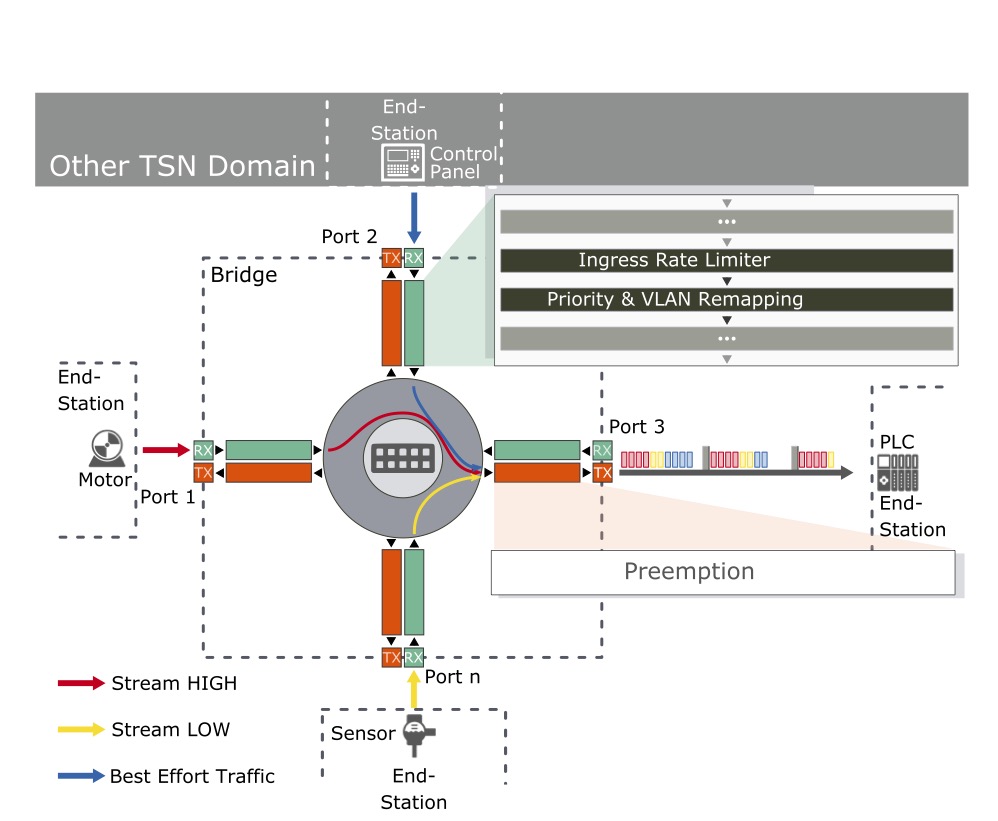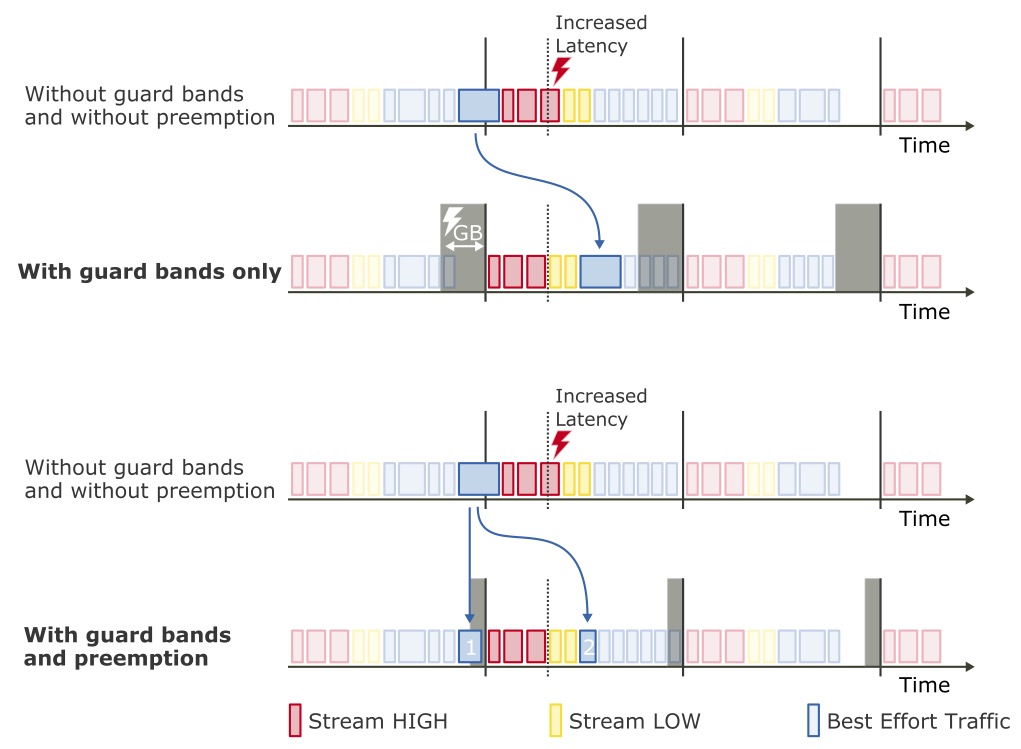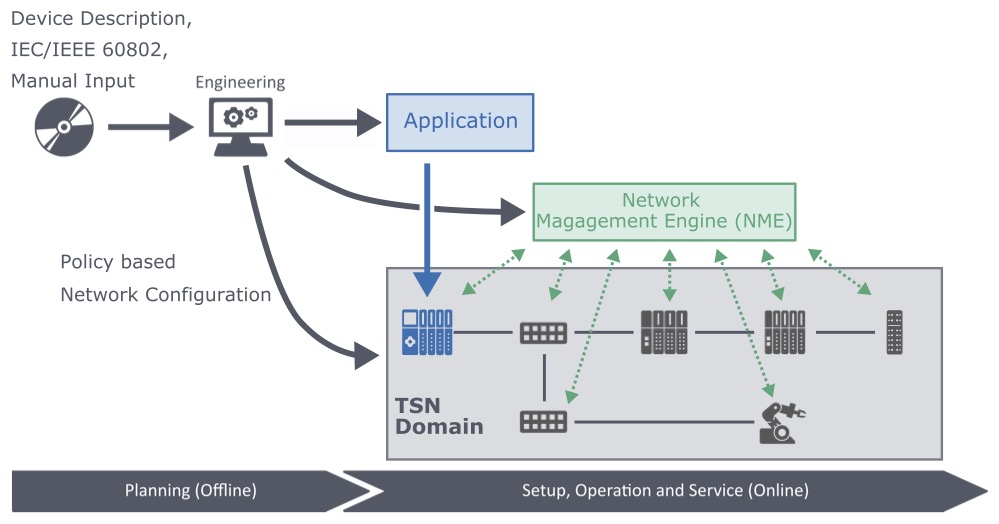Current industrial trends like Industry 4.0 and Industrial Internet of Things lead to more communication in ever-growing converged networks. Such networks require flexibility and scalability to support everything from small devices to machine and production line control devices as well as big data server systems. They also need to ensure bounded latency for time critical real-time communication. Time-Sensitive Networking (TSN) is defined by IEEE, the Ethernet standardization organization. It is intended to cover all these requirements to enable the simultaneous use of deterministic and non-deterministic communication in converged networks.
Before the features of TSN can be detailed, it should first be clarified that TSN is not a protocol. Instead, TSN is a generic term for a set of features collectively enabling standardized deterministic Ethernet. Without such features, standard Ethernet is not real-time capable. Note: the TSN features described below were chosen based on the IEC/IEEE 60802 Joint Profile for Industrial Automation.
Time Synchronization and Prioritization
Two long-established principles in Ethernet underpin TSN features: time synchronization and prioritization. First, TSN works best if the internal clock of each sender and receiver is synchronized to the other clocks on a network. Second, the data flowing through a network from a sender to a receiver is called a stream and is assigned a priority. IEC/IEEE 60802 specifies four priority classes. For our purposes, let’s simplify these to just three classes: high, low, and best-effort. If we take vehicles on a roadway as an analogy, prioritization would be akin to the HOV lanes on a highway.
Apart from senders and receivers, the other key piece of hardware in any network is the Ethernet switch, or in TSN parlance, a bridge. The features of a bridge can also be explained using the analogy of roads and vehicles. Bridges are best thought of as traffic circles. Vehicles enter the rotary (bridge), traverse the circle as necessary, and exit at the appropriate roadway. Similarly, Ethernet frames arrive at a bridge and are directed to the correct port without congestion loss. This prevention of congestion loss at bridges is one of the critical pieces of TSN.
Scheduling and Time Aware Shaper
Think of senders like a factory at the end of a shift. All the workers want to drive off at the exact same time. To avoid congestion loss (and maintain bounded latency) at the bridge, senders schedule the order in which they transmit their frames based on priority.
Once arriving at the bridge, prioritization alone is not the only method to determine which vehicles get to exit at their desired point. Internally, bridges can set up queues of similar priority frames. Algorithms would then determine the next frame per queue to be sent. This would imply the possibility that queues with lower priorities never get sent. Instead, priority queues are replaced by a repetitive cycle of time slots to ensure frames of all priorities can be sent. This is known as a time aware shaper (TAS) and is analogous to a city bus timetable. Every time slot starts with high-priority frames. Next in line are low-priority frames. Finally, the remaining time in the slot is filled with best-effort frames that do not rely on time awareness. In this way, all priorities get transmitted while maintaining determinism for high-priority traffic.
Preemption
At the end of each time slot, the TAS creates a short time window called a guard band. Its purpose is to ensure that the transmission of best-effort frames do not spill over into, and therefore delay, high-priority frames in the next slot. Often, best-effort frames are relatively large. In this case, the guard band must be as large as the transmission time for the potentially largest frame.
The TAS is inefficient with its bandwidth in this way. Instead, time-aware bridges can calculate the transmission time of these large best-effort frames and then decide whether they can complete their transmission by the end of the slot or not. If not, these frames are split into fragments, transmitted separately, and recombined at the next bridge. This procedure is called preemption. It minimizes the size of the guard band, eliminates latency and congestion loss, and maximizes timeslot utilization (i.e., best-effort traffic throughput).
TSN Boundaries
In converged networks, it is likely that a TSN domain will be connected to non-TSN capable devices, or even another TSN domain. Ports on bridges connected to devices outside the TSN domain are known as boundary ports. To protect network resources inside the domain, boundary ports invoke a function known as the ingress rate limiter.
If we return to the vehicles on a roadway analogy, the ingress rate limiter works like a highway onramp traffic light. The light regulates the access of vehicles to the motorway based on the traffic density on the highway.
These TSN boundaries are smarter than your typical traffic light, however. They can individually assign priorities, effectively allowing vehicles to join the HOV lanes directly. In technical terms, this is the remapping of priorities and VLAN assignments.
Network Management Engine
If all of this sounds terribly complex, that’s because it is! Even Ethernet today, if you were intimately aware of its inner workings, is quite complex. And yet, Ethernet is incredibly easy to use. The same applies to these complex TSN features. The software that enables and handles these mechanisms, according to IEC/IEEE 60802, is the TSN Domain Management Entity (TDME). Within Profinet, we call this the Network Management Engine (NME). The NME takes care of all calculations, planning, configuration, and resource allocation to make the administration of a TSN network easy—if not invisible to a user.
Summary
You may be asking yourself: Why do all of this? Don’t some features like these already exist in certain industrial Ethernet protocols (e.g., PROFINET)?
The answer is yes, but we’re not in it for the features, we’re in it for the benefits they yield. For example, because of IEEE standardization, a wide variety of hardware is available thanks to off-the-shelf TSN-capable Ethernet chips. This is beneficial to automation component vendors as it lowers costs and drives competition among technology providers. For end-users, the benefits are clear: Converged networks based on TSN enable plug-and-produce manufacturing. New machine and network concepts are now made possible by this technology.
